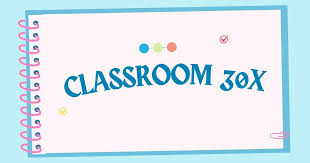Inch-by-Inch Improvements & Seamless GitHub Integration
In the evolving world of digital education, the classroom 30x platform is setting a new standard. With inch-by-inch upgrades in performance, seamless integration with GitHub, and a strong focus on delivering faster, more technical feedback, educators are discovering that classroom 30x may be the classroom of the future. This article is a must-read for educators, learners, and ed-tech enthusiasts looking to stay ahead of the curve. We’ll explore how this powerful tool transforms the learning experience, enhances classroom engagement, and empowers teachers and students alike. If you’ve been wondering how platforms like Google Classroom compare to this rising star—or how gaming, analytics, and structured lesson delivery fit into the new wave of digital classrooms—read on.
Article Outline
1. What Is Classroom 30x and How Does It Differ from Traditional Classrooms?
2. Why Is Faster Feedback Crucial in the Modern Classroom?
3. How Can GitHub Be Integrated into the Classroom 30x Platform?
4. What Are the Key Features That Make Classroom 30x Stand Out?
5. How Does Classroom 30x Support Both Teachers and Learners?
6. What Role Does Gaming Play in Today’s Classrooms?
7. How Do Platforms Like Google Classroom Compare?
8. How Can Classroom 30x Enhance Student Engagement?
9. What Challenges Do Educators Face in Adopting Classroom 30x?
10. How to Get Started with Classroom 30x: Devices, Tools, and Tips
1. What Is Classroom 30x and How Does It Differ from Traditional Classrooms?
Classroom 30x is a cutting-edge digital platform designed to enhance the modern educational environment. Unlike traditional classrooms, it offers a more interactive, immersive, and flexible structure that promotes student engagement and seamless access to assignments, resources, and feedback. The “30x” in the name hints at an amplified performance and productivity level compared to legacy systems, such as the classroom 15x model.
This platform integrates advanced features such as real-time dashboards, interactive whiteboards, and data-driven insights that help classroom teachers provide students with more targeted support. With its versatile architecture, classroom 30x enables educators to deliver lessons that are more adaptive and suitable for today’s digitally native learners.
2. Why Is Faster Feedback Crucial in the Modern Classroom?
In any classroom, feedback serves as a cornerstone of growth and development. On the classroom 30x platform, faster feedback loops allow teachers to identify knowledge gaps early, intervene quickly, and help students stay on track. This not only improves performance but also boosts confidence in learners who feel supported throughout their journey.
Unlike traditional grading systems that may delay responses, classroom 30x uses automation and AI-driven analytics to give students near-instant ratings and recommendations. This is especially effective in subjects requiring technical problem-solving, such as coding, mathematics, or science, where timing and relevance are key. Faster feedback leads to a more productive and structured classroom environment.
3. How Can GitHub Be Integrated into the Classroom 30x Platform?
One of the standout features of classroom 30x is its seamless integration with platforms like GitHub. This is especially valuable in coding or technical education environments, where students can submit assignments directly via GitHub repositories. Teachers can then review, comment, and rate the work in real time.
The integration of GitHub enables students to work in a version-controlled environment, improving their technical literacy while promoting best practices like collaboration, code documentation, and revision control. It also prepares learners for real-world challenges in software development—helping bridge the gap between academic tasks and industry expectations.
4. What Are the Key Features That Make Classroom 30x Stand Out?
Classroom 30x offers several key features designed to enhance education at every level:
- Interactive whiteboards for collaborative learning.
- Automated feedback systems that improve response time.
- Real-time dashboards that allow teachers to monitor progress.
- Flexible structure that suits various teaching styles and seating arrangements.
These features contribute to a learning experience that’s more immersive and engaging. With the added benefit of gamified learning platforms, classroom 30x not only makes learning fun but also meaningful, using data to personalize the educational journey.
5. How Does Classroom 30x Support Both Teachers and Learners?
The classroom 30x platform has been carefully designed to cater to both educators and learners. For teachers, it offers advanced tools like real-time dashboards and integrated lesson planning to help streamline workflows. Classroom teachers can also use built-in analytics to adjust teaching strategies based on student performance.
For learners, the platform provides seamless access to assignments, resources, and feedback. Students benefit from a flexible and interactive environment where they can explore concepts at their own pace, receive instant feedback, and engage in collaborative tasks. The platform promotes creativity, problem-solving, and critical thinking in a way that traditional setups often lack.
6. What Role Does Gaming Play in Today’s Classrooms?
Gaming is increasingly recognized as a powerful educational tool, and classroom 30x leverages this trend by integrating popular games and gamified learning platforms. These tools help engage students by transforming traditional lessons into immersive experiences that promote competition, creativity, and motivation.
Incorporating gaming into the classroom also addresses different learning styles. Visual learners benefit from graphics and animations, while kinesthetic learners thrive through interactive tasks. As a result, classroom 30x promotes better learner engagement and encourages them to participate more actively in lessons.
7. How Do Platforms Like Google Classroom Compare?
Platforms like Google Classroom have long dominated the digital education space. While Google Classroom is a reliable tool for managing assignments and integrating with apps like Google Drive, classroom 30x takes it a step further by offering deeper feedback mechanisms, better performance tracking, and a more technical, immersive experience.
Google Classroom remains suitable for general educational needs, but platforms like classroom 30x provide a more specialized, data-driven approach. In environments where interactive lessons, feedback automation, and real-time dashboards are crucial, classroom 30x emerges as a stronger contender.
8. How Can Classroom 30x Enhance Student Engagement?
Student engagement is one of the biggest challenges in modern education. Classroom 30x addresses this by offering a platform that is both engaging and effective. Through interactive content, real-time feedback, and collaborative tools, the platform enables students to take ownership of their learning.
The platform also supports integration with creative tasks and group projects, allowing learners to explore new ideas while developing technical skills. By integrating tools that promote creativity and collaboration, classroom 30x keeps learners interested and invested in their educational journey.
9. What Challenges Do Educators Face in Adopting Classroom 30x?
While the benefits are clear, adopting a new platform like classroom 30x comes with challenges. Educators may struggle with technical training, device compatibility, or resistance to change. Some classrooms may lack the infrastructure required for smooth integration, such as high-speed internet or modern hardware.
However, the platform is designed to be versatile and adaptable. With proper onboarding and support, even less technically inclined educators can quickly get up to speed. Once implemented, classroom 30x simplifies lesson delivery, streamlines feedback, and fosters a more productive learning environment.
10. How to Get Started with Classroom 30x: Devices, Tools, and Tips
Getting started with classroom 30x is easier than it seems. First, ensure that your classroom has the necessary devices—ideally tablets or laptops with a minimum screen size of 11 inches (or roughly one inch smaller, if adjustable settings allow). The platform is compatible with most modern operating systems.
Educators should begin by exploring the platform’s dashboard, customizing lesson structures, and integrating tools like GitHub or Google Drive. Initial training sessions can help classroom teachers become familiar with features such as assignment automation, real-time rating systems, and interactive whiteboards. These steps pave the way for a smoother, more engaging classroom experience.



